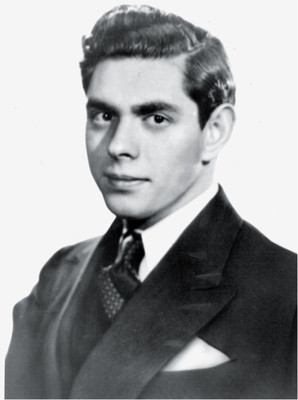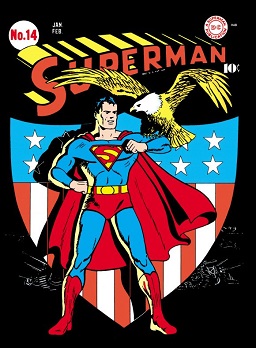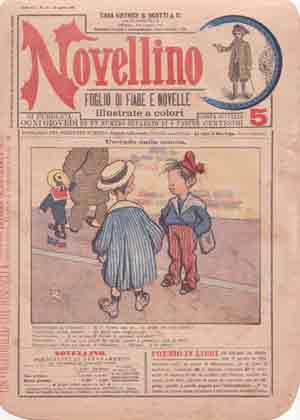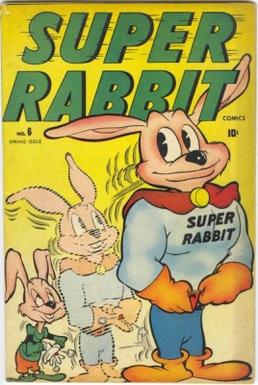| Founded | March 1941 |
|---|---|
| Defunct | 1951 |
| Country of origin | Canada |
| Headquarters location | Toronto, Ontario, Canada |
| Publication types | Comic books |
Anglo-American Publishing was a Canadian comic book publisher during the World War II era. While they published a number of Canadian creations, they also printed Canadian reworkings of scripts bought from American publisher Fawcett Comics.
As of 2017, Anglo-American characters have begun appearing in Chapterhouse Comics publications, later acquired by Lev Gleason Publications.
American comic books were barred from crossing the border into Canada when the War Exchange Conservation Act passed in December 1940. In order to fill in the void and supply Canadian kids' appetite for comic books, Anglo American and Maple Leaf Publishing started publishing comics in March 1941. [1]
Anglo-American's first title that March was Robin Hood and Company , a tabloid-sized publication which reprinted comic strips, [1] chief amongst them Robin Hood and Company by Toronto Telegram's [2] Ted McCall, which had run in Canadian newspapers since 1935. [3]
Amongst Anglo-American's characters were:

Joseph Shuster, was a Canadian-American comic book artist best known for co-creating the DC Comics character Superman, with Jerry Siegel, in Action Comics #1.

Comics is a medium used to express ideas with images, often combined with text or other visual information. It typically takes the form of a sequence of panels of images. Textual devices such as speech balloons, captions, and onomatopoeia can indicate dialogue, narration, sound effects, or other information. There is no consensus among theorists and historians on a definition of comics; some emphasize the combination of images and text, some sequentiality or other image relations, and others historical aspects such as mass reproduction or the use of recurring characters. Cartooning and other forms of illustration are the most common image-making means in comics; Photo comics is a form that uses photographic images. Common forms include comic strips, editorial and gag cartoons, and comic books. Since the late 20th century, bound volumes such as graphic novels, comic albums, and tankōbon have become increasingly common, along with webcomics as well as scientific/medical comics.

The Golden Age of Comic Books describes an era in the history of American comic books from 1938 to 1956. During this time, modern comic books were first published and rapidly increased in popularity. The superhero archetype was created and many well-known characters were introduced, including Superman, Batman, Robin, Captain Marvel, Captain America, and Wonder Woman.

Quality Comics was an American comic book publishing company which operated from 1937 to 1956 and was a creative, influential force in what historians and fans call the Golden Age of Comic Books.

Quebec comics are French language comics produced primarily in the Canadian province of Quebec, and read both within and outside Canada, particularly in French-speaking Europe.

An American comic book is a thin periodical originating in the United States, on average 32 pages, containing comics. While the form originated in 1933, American comic books first gained popularity after the 1938 publication of Action Comics, which included the debut of the superhero Superman. This was followed by a superhero boom that lasted until the end of World War II. After the war, while superheroes were marginalized, the comic book industry rapidly expanded and genres such as horror, crime, science fiction and romance became popular. The 1950s saw a gradual decline, due to a shift away from print media in the wake of television and the impact of the Comics Code Authority. The late 1950s and the 1960s saw a superhero revival and superheroes remained the dominant character archetype throughout the late 20th century into the 21st century.

Italian comics, also known as fumetto, plural form fumetti, are comics that originate in Italy. The most popular Italian comics have been translated into many languages. The term fumetto refers to the distinctive word balloons that contain the dialogue in comics.

Drawn & Quarterly (D+Q) is a publishing company based in Montreal, Quebec, Canada, specializing in comics. It publishes primarily comic books, graphic novels and comic strip collections. The books it publishes are noted for their artistic content, as well as the quality of printing and design. The name of the company is a pun on "drawing", "quarterly", and the practice of hanging, drawing and quartering. Initially it specialized in underground and alternative comics, but has since expanded into classic reprints and translations of foreign works. Drawn & Quarterly was the company's flagship quarterly anthology during the 1990s.

L. Miller & Son, Ltd. was a British publisher of magazines, comic books, pulp fiction and paperback books intended primarily to take advantage of the British ban on importing printed matter. Between 1943 and 1966, the firm published British editions of many American comic books, primarily those of Fawcett Comics and American paperback books, primarily those of Fawcett Publications' Gold Medal Books. The company is best known for the 1954 creation of Marvelman – a blatant imitation of the Golden Age Captain Marvel – after America's Fawcett Publications capitulated to National Periodicals. L. Miller & Son also published a large line of Western comics — many reprints but also some original titles - and both category fiction and non-fiction paperbacks.

Super Rabbit is a talking animal superhero in american comic books published by Timely Comics, a predecessor of Marvel Comics, during the 1930s and 1940s period fans and historians call the Golden Age of comic books. Created by cartoonist Ernie Hart, he first appeared in Comedy Comics #14.
Edwin Reid McCall was a Canadian journalist, and a comic strip and comic book writer. He was best known for creating the first comic strip based on the Royal Canadian Mounted Police, Men of the Mounted for the Toronto Evening Telegram and the war hero Freelance for Anglo-American Publishing.
Canadian cartoonist Chester Brown attracted the attention of critics and peers in the early 1990s alternative comics world when he began publishing autobiographical comics in his comic book Yummy Fur. During this period Brown produced a number of short strips and two graphic novels: The Playboy (1992) and I Never Liked You (1994). The personal and revealing deal with Brown's social awkwardness and introversion, and the artwork and page layouts are minimal and organic. In 2011 Brown returned to autobiography with Paying for It, an account of his experience with prostitutes.
Canadian Whites are World War II-era comic books published in Canada that feature colour covers with black-and-white interiors. Notable characters include Nelvana of the Northern Lights, Johnny Canuck, Brok Windsor, and Canada Jack. The period has been called the Golden Age of Canadian comics.
Maple Leaf Publishing was a World War II-era Canadian comic book publisher active during the Golden Age of Comic Books. They were one of four publishers—along with Anglo-American Publishing, Hillborough Studios, and Bell Features—which published "Canadian Whites"—black-and-white comic books with colour covers that proliferated during the war years when American imports were restricted. Maple Leaf Publishing started publishing comic books in March 1941 and went out of business in late 1946.
Hillborough Studios was a short-lived Canadian comic book publisher, founded in 1941, most notable for publishing Adrian Dingle's Nelvana of the Northern Lights.
Canadian comics refers to comics and cartooning by citizens of Canada or permanent residents of Canada regardless of residence. Canada has two official languages, and distinct comics cultures have developed in English and French Canada. The English tends to follow American trends, and the French, Franco-Belgian ones, with little crossover between the two cultures. Canadian comics run the gamut of comics forms, including editorial cartooning, comic strips, comic books, graphic novels, and webcomics, and are published in newspapers, magazines, books, and online. They have received attention in international comics communities and have received support from the federal and provincial governments, including grants from the Canada Council for the Arts. There are comics publishers throughout the country, as well as large small press, self-publishing, and minicomics communities.
Bell Features, also known as Commercial Signs of Canada, was a Canadian comic book publisher during the World War II era. They were the most successful of the publishers of "Canadian Whites", and published comics such as Adrian Dingle's Nelvana of the Northern Lights.

Iron Man is a Canadian fictional character, created by cartoonist Vernon Miller for Maple Leaf Publishing. A superhero, the character's debut was in the first issue of Better Comics in March 1941, a colour title, unlike most of the other Canadian comic books at the time which were printed in black-and-white and known as "Canadian Whites".